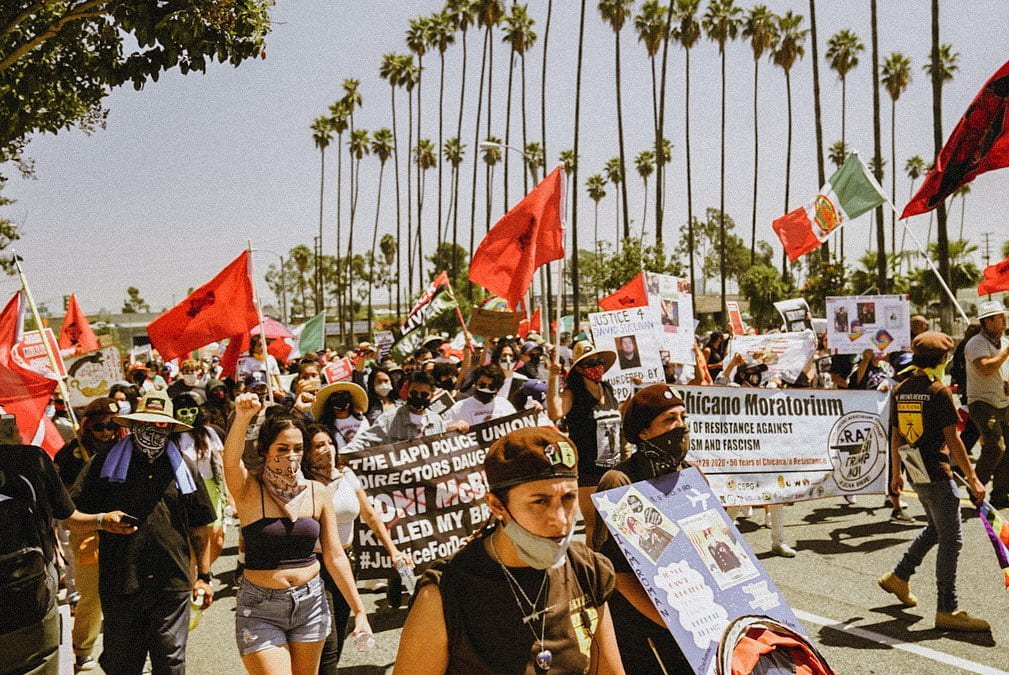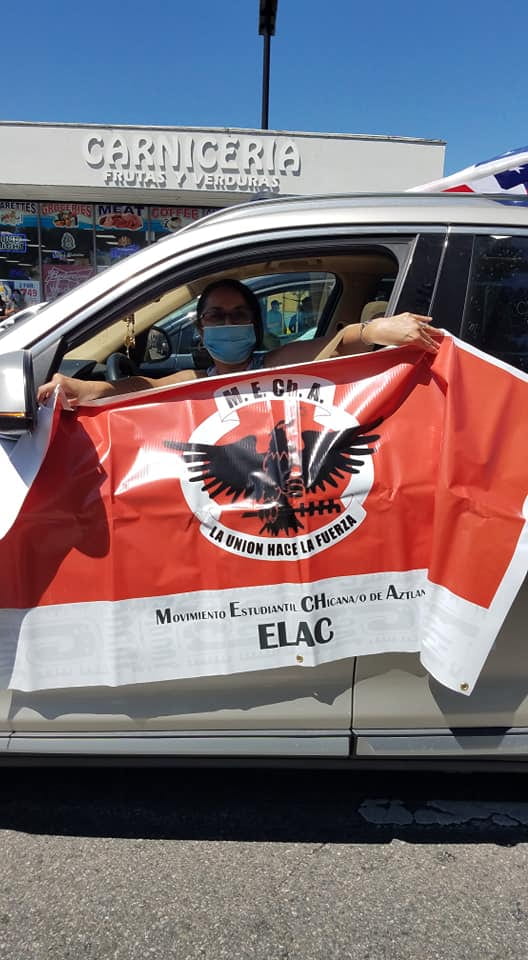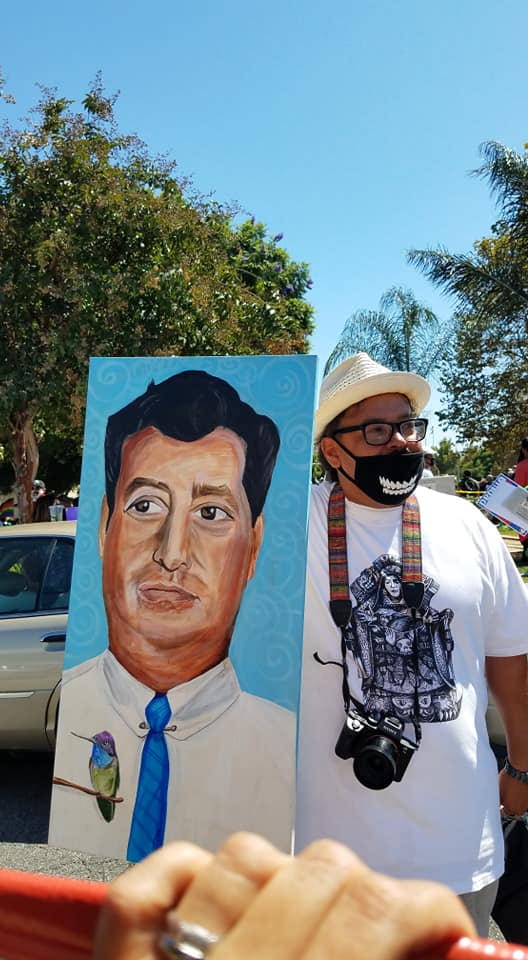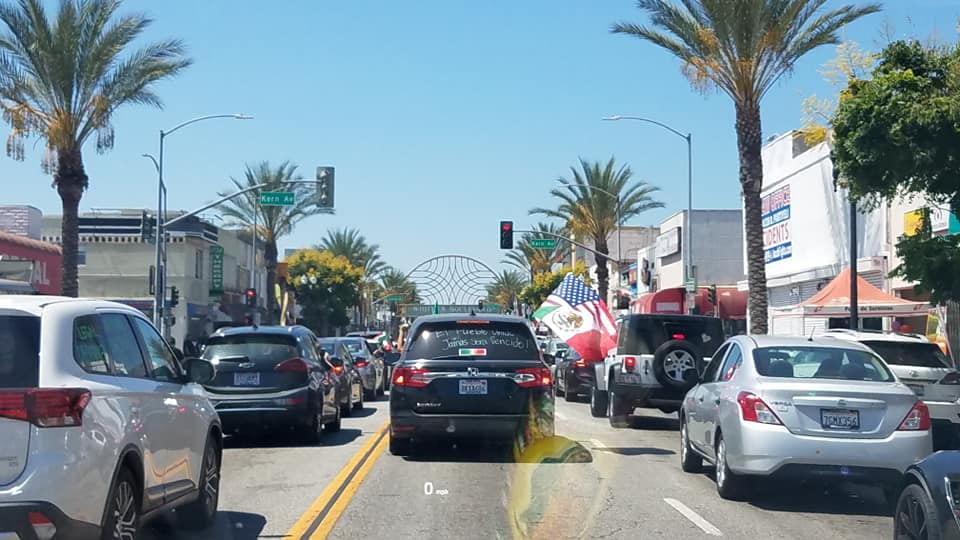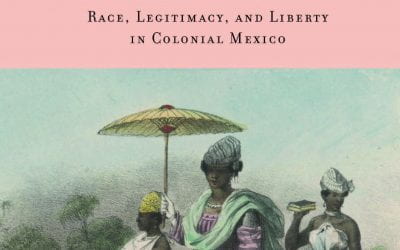Living in The Covid Years
The Chicanas/os and Latinx Golden State
Photos by Haydee Urita-Lopez and National Chicano Moratorium
Fifty years ago Saturday, 20,000 people marched through the streets of East Los Angeles to call for an end to the Vietnam War. The Chicano Moratorium Committee, made up mostly of young Mexican Americans under age 30, organized the protest in part to highlight the fact that Latino men were dying in the war (disproportionate) to their numbers in the population. Does that sound familiar? Today, as we battle the coronavirus, Latinos are once again on the front lines and dying in disproportionate numbers.
— Ernesto Chavez, UTEP Professor, op-ed, The Los Angeles Times, August 28, 2020
In August 2020, thousands paraded in classic cars and lowriders in East Los Angeles, as Chicanas and Chicanos celebrated the 50th anniversary of the National Chicano Moratorium to remember when 30,000 marched in peaceful protest to question the overrepresentation of Latinos dying in Indochina. In 1970, peaceful protestors, who gathered at Laguna Park in East Los Angeles, were shot with tear gas indiscriminately, even those with children. Tragically, civil rights activist Ruben Salazar was instantly killed by a canister of tear gas shot through his head. Fifty years later, Latinos of all ages are impacted disproportionally as coronavirus rages across the state.
Southeast Los Angeles County, with Latino-heavy neighborhoods, became the state’s epicenter of coronavirus infections, according to the Los Angeles Times. Los Angeles County Supervisor Hilda Solis, former U.S. Labor Secretary under Obama, authored a motion to improve and expand mental health care for underserved Latino communities. Solis cited data showing Latinos as one of the hardest-hit groups economically. Dr. Sandra Salazar, on the front line in urgent care at Kaiser Medical Center in Downey, declared, “I’m scared as a mother and as a physician… our hospitals are short on ventilators and ICUs are almost at capacity,” During an interview on Buelna News with Dr. Gabriel Buelna, Dr. Salazar warned about undertesting and growing diagnosis of “the working class of our community,” Latino janitors, law enforcement, union workers and many undocumented.
The “nation-state” of California—with its large Latino population—has lagged only behind the behemoth Brazil, which has recorded 4.7 million cases and close to 150,000 deaths, while neighboring Mexico had three-quarters of a million infections and almost 80,000 deaths at the time of writing. Covid-19 has hit the Americas hardest of all the regions on earth, according to the World Health Organization.
All across the United States, African Americans, Latinos and Native Americans emerged early in the crisis as overrepresented among reported coronavirus infections and deaths. An NPR analysis indicates that in 20 states, Latinos account for a number of deaths “greater than their share of the population, up from just seven in May.” Latinos are also less likely than whites to have health insurance—nearly 10 million uninsured Latinos or almost 20 % of an estimated population of 52 million, according to Unidos US, formerly the National Council of La Raza.
In another report by the National Urban League, “The State of Black America Unmasked,” Black people and Latinos were found to be four times more likely than white people to be hospitalized. The coronavirus infection rate for Blacks is 62 per 10,000, compared with 23 per 10,000 for whites. Latinos fared even worse at 73 infections per 10,000. An NPR analysis stated that Latinos “have a disproportionate rate of infection in 45 states and the District of Columbia.” In Virginia, Latinos make up 10% of the population but make up 49% of all cases. The racial disparities reported by NPR and the New York Times indicate the disproportionate numbers of Blacks, indigenous and Latinos. Latinos are least likely to work from home at 16% than blacks at 19.7%, compared to white people at 29.9% per a study by Johns Hopkins Center for Health Equity. Latinos are more likely to live in crowded housing and less likely to hold jobs that allow them to work from home, according to the Johns Hopkins report.
In California today, more than 800,000 of the entire population have been infected and over 15,000 have died statewide. The greater Los Angeles metropolitan area alone (a five-county area of Los Angeles, Orange, Riverside, San Bernardino and Ventura) have over half of the state’s infections at 400,000 and well over half of the deaths at 10,000 The Los Angeles metropolitan area, known as “The Southland”, accounts for 18.7 million residents, of which eight million are Latinos (US Census). The Southland is the seventh largest Latino population in the world, larger than Madrid and Santiago, Chile both tied at 6.6 million inhabitants, other sizeable metropolis in the millions are: São Pablo 22; Mexico 21.7; Buenos Aires 15.1; Rio 13.4; Lima 9.9; and Bogota 9.2. The Southland accounts for 13%, of 60 Million U.S. Latinos (Pew). The contribution of Southland Latinos in agribusiness, arts, business, economy, education, entertainment, film, manufacturing, medicine, media, production, transportation and workforce impacts the regional and the nation.
The situation is not that different in Northern California. Associate Professor and Chief of Hospital Medicine at the University of California San Francisco, Dr. Lenny Lopez M.D., MDiv., MPH Harvard alumnus stated, “Socioeconomic disparities, overcrowded housing, lack of health coverage and a higher number of essential workers exacerbate the situation among Latinos.” Dr. Alicia Fernandez, Professor of Medicine at UCSF, internist at Zuckerberg San Francisco General Hospital, shared her first-hand observations with NPR on how Latinos who made up 35% of patients at the local hospital before the pandemic, now make up over 80% of coronavirus cases. “In the early stages, when we were noticing increased Latino hospitalization at our own hospital and we felt that no one was paying attention and that people were just happy that San Francisco was crushing the curve, it felt horrendous. … It felt as if people were dismissing those lives. … It took people longer to realize what was going on,” she told NPR. Professor Hector Rodriguez, a Harvard alumnus, is working with the UC Berkeley Public Health and other schools in the University of California system to use telehealth to track and improve treatment for low-income patients across the Golden State, many of them Latino and Black.
In the interior of California, the impact of coronavirus on people of color was felt hardest on Latinos. Imperial Valley U.S. Representative Raul Ruiz, Harvard M.D., M.P.P., M.P.H., joined Jill Biden, former second lady of the United States, in a virtual summit, at which coronavirus and the impacts on health care and Latino communities were discussed. Congressmember Ruiz addressed the challenges of asymptomatic infections at home with people who live with elderly relatives, or other family members with asthma and/or diabetes.
Latinos in California have been impacted further by the economy. Latinos often hold jobs in health care, food production and as essential workers in higher numbers, according to Unidos US. Latinos were already impacted by low wages and earning gaps when compared to the rest of the population, receiving a disproportionate lack of paid family leave. Those who are underemployed, and unemployed, have had and continue to make desperate decisions based on a new economic reality under the coronavirus pandemic. These conditions are heightened for subgroups within the Latino demographic, for example the LGBTQ community. During a virtual conversation with Wilfred Labiosa from WAVES & SAGE Puerto Rico along with Rosanna Marzan, Diversidad Dominicana, discussions ensued on the loss of jobs among LGBTQ community and the frequency with which these same people had to return to a parent’s home. In some cases, these same homes where homophobic, abusive and aggressive, fueled by verbal, mental and physical harassment, conditions which exacerbate already toxic environments. Latino LGBTQ in California have also been impacted by the economic downturn post-coronavirus and have had to make drastic decisions.
Education for Latinos in California continues to be the great equalizer. The Latino population is young, more than half of Latinos are under 18 years of age. Four of the largest educational systems in the world are in California, two of which are in Los Angeles. East Los Angeles College at 36,000 students is the flagship of the Los Angeles Community College District (LACCD) serving 220,000. With an annual budget of nearly four billion dollars, the college system went fully online at the early stage of the pandemic shared Chancellor Francisco Rodriguez, following the California State University (CSU) system and the University of California (UC). The Los Angeles Unified School District (LAUSD), also the nation’s second largest school district closed, and remains closed at the writing of this article. Intergenerational Latino families are home, from pre-K and elementary, to college students, and, furthermore, are in overcrowded housing with limited space. Technology gaps exist, and underemployed and limited economic means inevitably lead to a lack of adequate health coverage and limited access to food. When Latino youth are not in school, they are the backbone of essential workers for the State of California.
The top three election issues for Latinos are the economy, health and Covid-19, according to Pew. According to Unidos US, ”Latinos stand to be the largest minority voting bloc in 2020.” California has more immigrant eligible voters at 5.5 million in the country, compared to any other state. In a poll released during the Latino Community Foundation webinar, challenges like Covid-19, awareness of vote-by-mail, deciphering the language of propositions, racial injustice, voting and voter registration were identified and raised.
Latinos pray as, “Covid-19 has brought a new reformation to today’s church. Latino pastors (and pastors in general) have had to reinvent themselves and reinvent their churches, including liturgy, pastoral care, and use of technology.” shared Pastor Martin Garcia, “This new Reformation has moved the church to a new dimension where churches (even the most conservatives) are open to everyone and everyone has access to them, independently of who they are. For the first time, everyone is welcome to all churches.” Pastor Garcia, who oversees a New Reformation, is also a community organizer and a well-recognized, prophetic voice on behalf of the voiceless. While some conservative white evangelical pastors protested Governor Gavin Newsom and even sued him, most Catholic, Protestant and Latino evangelicals chose to be proactive, reinventing themselves on-line, uploading their digital presence using multimedia formats to reach their parishioners, comfort the sick and heal families and loved ones affected by the ravages of this disease.
Recently, when news broke of the Department of Homeland Security and U.S. Immigration and Customs Enforcement’s (ICE) announcement of its rescission plans barring international students from remaining in the United States, challenges mounted in opposition, including from the business and technology sectors stemming from numerous lawsuits. The Trump Administration’s directive was halted effective immediately due to this pressure. The Los Angeles Community College District Chancellor Francisco Rodriguez stated, “The decision is a tremendous victory for student access and opportunity, and for about 1,300 international students who are currently enrolled at LACCD’s nine colleges. We are grateful to see such a negative and unwarranted policy against hard-working international students stopped, but we must continue to remain vigilant in our ongoing advocacy efforts to support the rights of all students, including DACA, undocumented, international, re-entry, veterans, LGTBQIA+ and other vulnerable student populations who need our help more than ever during …Covid-19.” This victory for immigrants, DACA and undocumented Latino students in the face of the Trump administration had another opportunity to study and continue their education and pursuit of their dreams.
In California, the Coalition for Human Immigrant Rights (CHIRLA) and 60 organizations urged Governor Gavin Newsom to create a state response for immigrant communities that included access to testing treatment and economic relief. The state legislature approved one billion dollars to combat Covid-19. California’s essential workforce is one-third immigrant – essential jobs such as caring for the sick and ensuring food security during the crisis. Mayor Eric Garcetti assembled a large local effort that included outreach to all Angelenos, including immigrant affairs and organizations like Comunidades Indigenas en Liderazgo (CIELO)who provide services and outreach to over 20 indigenous language communities of Los Angeles to keep families healthy. While family separation is an administration policy, California immigrant organizations continue to fight and be a thorn in the side of the federal government.
The glimmer of hope is that Covid-19 exposed the ways in which Latinos are vulnerable, especially the working poor and those who don’t hold U.S. citizenship. By early voting, large numbers of Latinos were voting for the first time. According to Unidos US, ”Latinos stand to be the largest minority voting bloc in 2020.” California has more immigrant eligible voters at 5.5 million in the country, compared to any other state. In a poll released during the Latino Community Foundation webinar, challenges like Covid-19, awareness of vote-by-mail, deciphering the language of propositions, racial injustice, voting and voter registration were identified and raised. Thirty-two million Latinos are projected to be eligible to cast a vote in the upcoming Presidential election in November of 2020. The sleeping giant is waking up.
Felipe Agredano, Harvard Divinity School MTS ’97 was a former DRCLAS intern. He is faculty at East Los Angeles College where he teaches Chicana/o Studies, Political Science and US Citizenship. He has taught at Harvard University and CalState University Northridge. He resides in the City of Angels and often contributes to national/international stories: CNN Español, La Opinion, Los Angeles Times, NBC/Telemundo, TNT, Univision and The Wall Street Journal.
To contact Felipe:
E-mail – Agredano@Alumni.Harvard.edu
FB – TeologoFelipeAgredano
IG – @FelipeAgredano
TW – #FelipeAgredano
LI – Agredano
YT – FelipeAgredano
Related Articles
Editor’s Letter – Eyes on COVID-19
Editor's Letter Documenting Covid-19 It’s been two years, two months and some days since we published Olivia Liendo’s powerful article “With Covid-19, We are All Immigrants.” Relating how friends, family and strangers came together to help her mother in Venezuela...
A Review of The Rebel Scribe: Carleton Beals and the Progressive Challenge to U.S. Policy in Latin America
This is how the adventure of the 25-year-old from Kansas begins: “I began to dream dreams, extravagant dreams. I would stay here in this city of the Aztecs and the Conquistadors ..
A Review of The Capital of Free Women: Race, Legitimacy, and Liberty in Colonial Mexico
Ever since James Lockhart published Spanish Peru in 1968, historians of colonial Latin America have mined the notarial archives to illuminate the daily lives of people who were largely…

